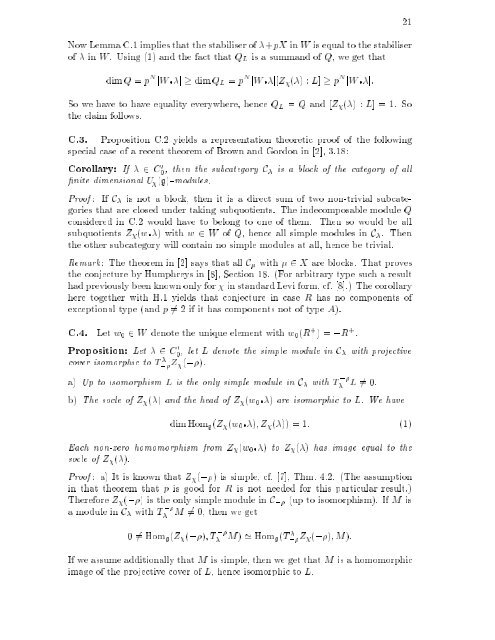subregular nilpotent representations of lie algebras in prime ...
subregular nilpotent representations of lie algebras in prime ...
subregular nilpotent representations of lie algebras in prime ...
You also want an ePaper? Increase the reach of your titles
YUMPU automatically turns print PDFs into web optimized ePapers that Google loves.
Now Lemma C.1 imp<strong>lie</strong>s that the stabiliser <strong>of</strong> +pX <strong>in</strong> W is equal to the stabiliser<br />
<strong>of</strong> <strong>in</strong> W . Us<strong>in</strong>g (1) and the fact that QL is a summand <strong>of</strong> Q, we get that<br />
dim Q = p N jW j dim QL = p N jW j[Z ( ):L] p N jW j:<br />
So we have tohave equality everywhere, hence QL = Q and [Z ( ):L] = 1. So<br />
the claim follows.<br />
C.3. Proposition C.2 yields a representation theoretic pro<strong>of</strong> <strong>of</strong> the follow<strong>in</strong>g<br />
special case <strong>of</strong> a recent theorem <strong>of</strong> Brown and Gordon <strong>in</strong> [2], 3.18:<br />
Corollary: If 2 C 0 0 , then the subcategory C is a block <strong>of</strong> the category <strong>of</strong> all<br />
nite dimensional U (g){modules.<br />
Pro<strong>of</strong> : If C is not a block, then it is a direct sum <strong>of</strong> two non-trivial subcategories<br />
that are closed under tak<strong>in</strong>g subquotients. The <strong>in</strong>decomposable module Q<br />
considered <strong>in</strong> C.2 would have to belong to one <strong>of</strong> them. Then so would be all<br />
subquotients Z (w ) with w 2 W <strong>of</strong> Q, hence all simple modules <strong>in</strong> C . Then<br />
the other subcategory will conta<strong>in</strong> no simple modules at all, hence be trivial.<br />
Remark: The theorem <strong>in</strong> [2] says that all C with 2 X are blocks. That proves<br />
the conjecture by Humphreys <strong>in</strong> [8], Section 18. (For arbitrary type such a result<br />
had previously been known only for <strong>in</strong> standard Levi form, cf. [8].) The corollary<br />
here together with H.1 yields that conjecture <strong>in</strong> case R has no components <strong>of</strong><br />
exceptional type (and p 6= 2 if it has components not <strong>of</strong> type A).<br />
C.4. Let w0 2 W denote the unique element withw0(R + )=,R + .<br />
Proposition: Let 2 C 0 0 ,letLdenote the simple module <strong>in</strong> C with projective<br />
cover isomorphic to T , Z (, ).<br />
a) Up to isomorphism L is the only simple module <strong>in</strong> C with T , L 6= 0.<br />
b) The socle <strong>of</strong> Z ( ) and the head <strong>of</strong> Z (w0 ) are isomorphic to L. We have<br />
dim Homg(Z (w0 );Z ( )) = 1: (1)<br />
Each non-zero homomorphism from Z (w0 ) to Z ( ) has image equal to the<br />
socle <strong>of</strong> Z ( ).<br />
Pro<strong>of</strong> : a) It is known that Z (, ) is simple, cf. [7], Thm. 4.2. (The assumption<br />
<strong>in</strong> that theorem that p is good for R is not needed for this particular result.)<br />
Therefore Z (, ) is the only simple module <strong>in</strong> C, (up to isomorphism). If M is<br />
amodule<strong>in</strong>C with T , M 6= 0, then we get<br />
0 6= Homg(Z (, );T , M) ' Homg(T , Z (, );M):<br />
If we assume additionally that M is simple, then we get that M is a homomorphic<br />
image <strong>of</strong> the projective cover <strong>of</strong> L, hence isomorphic to L.<br />
21

















